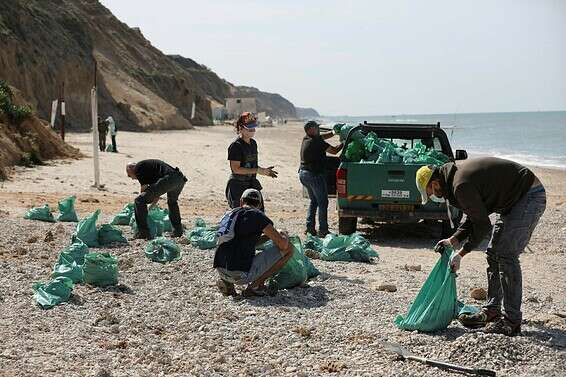According to the Ministry of Environmental Protection, most of the pollution that remains is more difficult and complex to remove and evacuate. • About 70 tons of tar and debris have been collected since the beginning of the incident.
Significant damage on the order of 30% to 40% was caused in large rocky areas on some of the beaches damaged by the tar pollution disaster, according to an updated estimate published today (Wednesday) by the Ministry of Environmental Protection.
[video]
According to the assessment, among the affected beaches are the beaches of Hof Hacarmel, Haifa, Betzet, Achziv and Rosh Hanikra.
With regard to the damage to marine animals, it is known at this stage that 10 sea turtles have died and six are in rehabilitation at the Sea Turtle Rescue Center.
In addition, there is also a point damage to the life of the water, including crabs, lake gulls and more.
Some of the concerns about the nature of the damage to the sea stem from the fact that there are water-soluble substances, some of which will sink to the bottom.
In practice, small organisms, marine invertebrates and fish may be harmed.
"There may be an accumulation of pollutants in the food web and we will soon begin researching and analyzing the implications as part of the national monitoring program," notes Chief Scientist at the Ministry of Environmental Protection, Professor Noga Kronfeld-Schur.
In this context, the fact that the spring migration is approaching does not bode well, this is because a large number of birds are expected to arrive in our area soon, and these may be exposed to infection - whether directly or by animal feed.
The Institute for the Study of Seas and Lakes sampled seawater yesterday for the purpose of investigating pollutants, and in accordance with the results, shared with the Ministry of Health, the aim is to open the bathing beaches in a timely and safe manner.
Among other things, the ministry is collaborating with American scientists who took part in investigating the 2010 Gulf oil spill disaster in the Gulf of Mexico.
According to estimates by the Nature and Parks Authority, since the beginning of the tar pollution incident, about 70 tons of tar and debris have been collected on the beaches of the nature reserves and national parks.
In practice, most of the pollution currently remains in the rocky surfaces on the beaches, with this pollution being more difficult and complex to remove and evacuate.
Meanwhile, most of the beaches and sandy surfaces are relatively clean, although there are still tar deposits in small lumps (the size of flakes or coins) along the beaches.
In addition, the Ministry of Environmental Protection today began operating the executive arm of the ministry, the company for environmental services, for the collection and removal of about 1,200 tons of tar and waste from the beaches.
The current situation requires filtering of the sand in large areas by large teams.
Among other things, the Authority continues to examine mechanical and technological means for treating small lumps of tar, along with more advanced means for treating tar on rocky surfaces.
About 2,000 volunteers from organized groups and individuals assisted the inspectors and employees of the authority yesterday in the efforts to clean and rehabilitate the beaches from the pollution of the tar on the shores of nature reserves and national parks, from north to south.
The volunteers were registered through the volunteer registration and placement system established by the Nature and Parks Authority on its website, combined with about 13 volunteer absorption stations set up by the authority on the shores of nature reserves and national parks.
Tomorrow, about 200 workers and medical staff from hospitals across the country are expected to join the groups of volunteers cleaning and rehabilitating the beaches, including medical teams who have been dealing with the corona virus throughout the past year.

